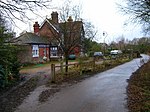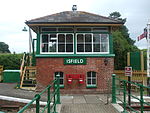Barcombe

Barcombe is an East Sussex village and civil parish in the Lewes District of East Sussex. The parish has four settlements: old Barcombe (TQ 418 143), the oldest settlement in the parish with the parish church; Barcombe Cross (TQ 420 158), the more populous settlement and main hub with the amenities and services; the hamlet of Spithurst (TQ 426 174) in the north east and Town Littleworth (TQ 410 180) in the north west. Barcombe was recorded in the Domesday Book as "Berchamp". The origins of the place name 'Barcombe' may have derived from two sources: the Saxon 'Berecampe', meaning 'barley land' and the Latin loan word 'campus', a field.Barcombe is particularly noted to Sussex residents and tourists for 'Barcombe Mills', a reference to an old water-mill complex on the River Ouse at the base of the hill/plateau on which Barcombe Cross sits. The mills burnt down before the Second World War, but Barcombe Mills is still a popular Sunday outing for townsfolk from Lewes and Brighton.
Excerpt from the Wikipedia article Barcombe (License: CC BY-SA 3.0, Authors, Images).Barcombe
Geographical coordinates (GPS) Address Nearby Places Show on map
Geographical coordinates (GPS)
| Latitude | Longitude |
|---|---|
| N 50.923 ° | E 0.018 ° |
Address
BN8 5BB , Barcombe
England, United Kingdom
Open on Google Maps










